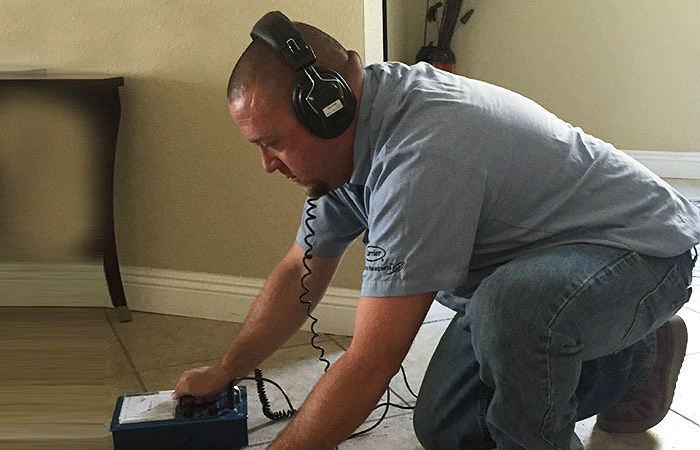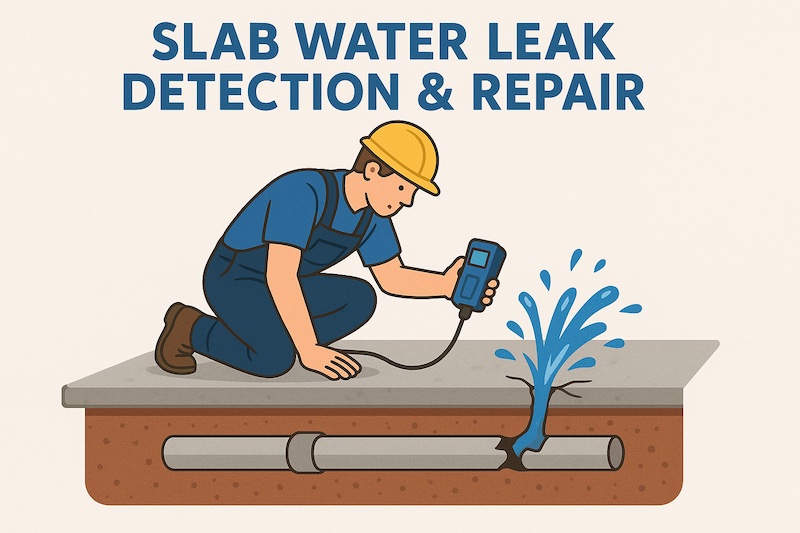Slab leaks are a serious issue that can cause extensive damage to your home if left untreated. These leaks occur in the water pipes located beneath the concrete foundation of your house, often going unnoticed until significant problems arise. Detecting and repairing slab leaks early can save homeowners thousands of dollars in repair costs and prevent structural damage. Protect your home from costly water damage with professional slab leak detection Arlington services. In this comprehensive guide, we will cover everything you need to know about slab leak detection, signs of a leak, repair methods, and preventative measures.
What Is a Slab Leak?
A slab leak is a leak that occurs in the plumbing pipes under the concrete foundation, or slab, of a home. These leaks are most common in homes built after the 1970s with copper, PVC, or PEX pipes running beneath the concrete slab. Due to their hidden location, slab leaks can go undetected for months, allowing water to erode the foundation and create mold, mildew, and structural damage.
Slab leaks can originate from several causes, including pipe corrosion, shifting soil, high water pressure, or poor construction practices. Understanding what a slab leak is and how it forms is the first step toward timely detection and repair.
Common Causes of Slab Leaks
Several factors can contribute to slab leaks, including:
-
Pipe Corrosion: Older copper pipes are prone to corrosion, which can lead to tiny holes or cracks over time.
-
Shifting Soil or Foundation Movement: Soil expansion and contraction beneath the slab can stress pipes, causing them to crack or break.
-
High Water Pressure: Excessive water pressure can put undue stress on pipes, leading to leaks.
-
Poor Installation: Pipes installed incorrectly or without proper support are more likely to fail prematurely.
-
Temperature Fluctuations: Extreme heat or cold can cause pipes to expand and contract, eventually leading to leaks.
By understanding these causes, homeowners can take steps to prevent slab leaks and minimize the risk of damage.

Signs You May Have a Slab Leak
Detecting a slab leak early is critical to avoiding costly repairs. Some common signs include:
-
Unexplained Increase in Water Bills: A sudden spike in your water bill may indicate a hidden leak.
-
Warm Spots on the Floor: Leaks from hot water pipes can cause sections of your floor to feel unusually warm.
-
Water Pooling or Damp Spots: Moisture appearing on your floor or near walls can be a sign of a leak beneath the slab.
-
Low Water Pressure: A noticeable drop in water pressure in faucets or showers may indicate a leak.
-
Cracks in Walls or Flooring: Slab leaks can lead to foundation movement, resulting in cracks.
-
Mold or Mildew Growth: Unexplained mold growth inside the home can be a red flag for hidden water leaks.
Recognizing these signs early and contacting a professional for slab leak detection can prevent further damage to your home.
Methods for Detecting Slab Leaks
Professional slab leak detection involves advanced technology to locate leaks without unnecessary destruction to your property. Common methods include:
-
Electronic Amplification: Uses specialized listening devices to detect the sound of water escaping from pipes.
-
Infrared Cameras: Helps detect heat changes in floors that may indicate leaking hot water pipes.
-
Video Camera Inspection: Involves inserting a small camera into the pipes to visually identify leaks or damages.
-
Pressure Testing: Measures water pressure in the pipes to identify drops that indicate a leak.
-
Tracer Gas Detection: A non-toxic gas is introduced into the plumbing system, which escapes from leaks and is detected using sensors.
Using these modern techniques, professionals can accurately locate leaks with minimal disruption to your home.
Slab Leak Repair Options
Once a slab leak is detected, the next step is repair. The method of repair depends on the location and severity of the leak. Common repair options include:
-
Pipe Rerouting: Involves redirecting the plumbing around the damaged section, eliminating the need to break the slab.
-
Pipe Replacement: In severe cases, the damaged section of the pipe may need to be removed and replaced.
-
Spot Repair: For minor leaks, only the affected section of the pipe is repaired.
-
Repiping the Entire Slab: For older homes with multiple leaks or deteriorating pipes, repiping the entire system beneath the slab may be the most effective long-term solution.
Professional plumbers will assess the situation and recommend the most efficient and cost-effective repair method for your home.
Costs Associated with Slab Leak Detection and Repair
The cost of slab leak detection and repair varies depending on the severity, location, and repair method chosen. On average, detection costs range from $150 to $500, while repair costs can vary from $1,000 for a small repair to over $10,000 for extensive repiping. Factors affecting cost include:
-
Accessibility of the pipes beneath the slab
-
Type of piping material
-
Extent of damage
-
Labor and equipment needed for repairs
-
Any additional work, such as flooring replacement or foundation repair
Investing in early detection can save homeowners significant expenses by preventing secondary damage from water leaks.
Preventing Slab Leaks
While not all slab leaks can be avoided, several preventative measures can reduce the risk:
-
Regular Plumbing Inspections: Periodic professional inspections help identify early signs of pipe corrosion or leaks.
-
Maintain Proper Water Pressure: Installing a pressure regulator can prevent excessive stress on pipes.
-
Install PEX Piping: Flexible PEX pipes are more resistant to shifting soil and temperature changes than older copper pipes.
-
Monitor Water Usage: Keep an eye on your water bill for unexpected increases that could indicate hidden leaks.
-
Address Foundation Issues Promptly: Preventing foundation movement reduces the risk of pipe damage beneath the slab.
By taking these proactive steps, homeowners can extend the life of their plumbing system and minimize the likelihood of slab leaks.
Why Hiring a Professional Matters
Slab leaks are hidden, complex, and potentially damaging, making professional expertise essential. DIY attempts at detection or repair can lead to further damage or costly mistakes. Experienced plumbers use advanced detection technology, accurately pinpoint leaks, and recommend appropriate repair methods. Hiring a professional ensures the job is done correctly, efficiently, and with minimal disruption to your home.
Final Thoughts
Slab leaks are a serious concern for homeowners, but with proper detection, timely repairs, and preventative measures, the risks and costs associated with them can be significantly reduced. Understanding the signs, causes, and repair options empowers homeowners to take action before minor leaks turn into major problems.
If you suspect a slab leak in your home, don’t wait. Contact a professional for expert slab leak detection and repair to protect your property, prevent structural damage, and maintain the safety and comfort of your home.

